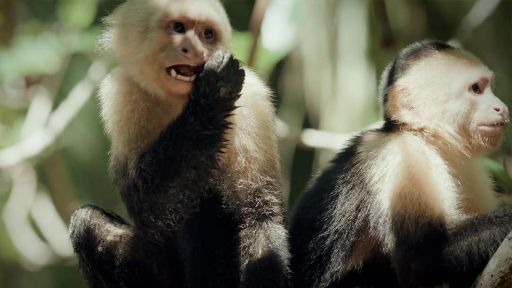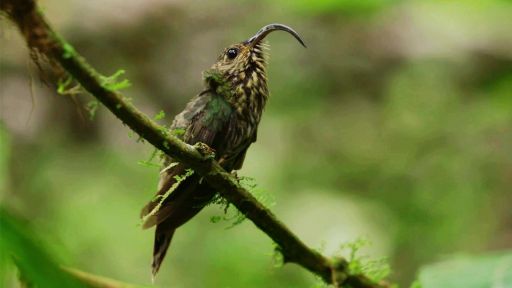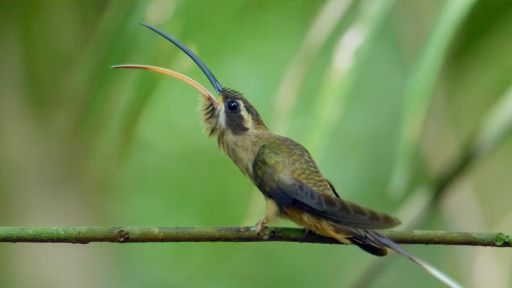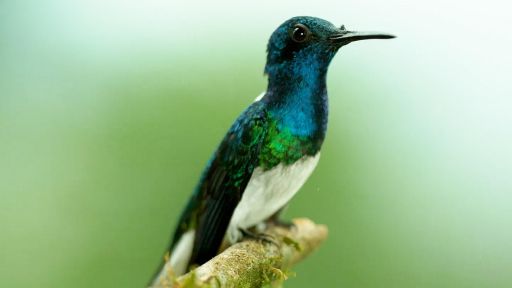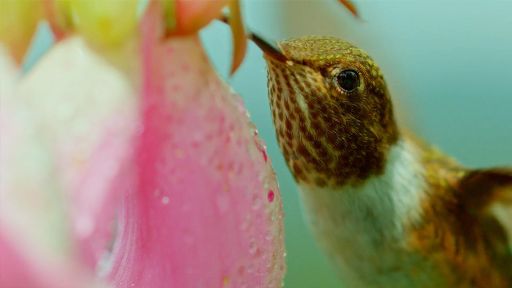TRANSCRIPT
♪♪ SHUM: In Costa Rica, the national motto is "pura vida," pure life.
And here, life is everywhere.
Over half a million species make this small country a biodiversity giant.
And it's thanks, in part, to one tiny creature... the hummingbird.
Hummingbirds are the impossible incarnate.
Masters of miraculous flight... cloaked in otherworldly colors... A glimmer in the green... and they're gone.
♪♪ But their effect lingers... bringing flowers to the fields... and fruit to the forest... ...where a whole community of creatures enjoys "The Hummingbird Effect."
♪♪ ♪♪ ♪♪ SHUM: Cradled between the sultry Caribbean and the wild Pacific, Costa Rica's vast green frontier stretches across the heart of Central America.
And here, the wellsprings of life are flowers... and the mysterious little gardeners whose lives depend on them.
♪♪ In the eastern hills, just at the forest edge, a vast terrain is overseen by... a very small caretaker.
Blink and you could miss him -- just over 2 inches tall, hardly bigger than a bumblebee.
A wispy mohawk of feathers gives him his name: the black-crested coquette.
Today, one little coquette has hit the jackpot: a patch of nectar-rich verbena flowers.
But an easy food source is a precious commodity.
Another male makes a bold challenge for the verbena buffet.
When the time comes to defend his flowers, the black-crested coquette is elegant not just in appearance but also in combat.
♪♪ In a ritualized duel, they engage in a mid-air stare-down.
♪♪ Feet flared, laser focused... who will be the first to flinch?
♪♪ Hummingbirds are always within a few hours of starvation.
Defending his food source is a matter of life or death.
♪♪ For the most part, there's no contact.
Although occasionally, they test the limits.
♪♪ The intruder makes a move to claim the flowers.
It's the final straw.
♪♪ The victor claims his hard-won reward... not a tufted plume out of place.
♪♪ Tiny battles over flowering plants have played out across Costa Rica for millions of years... shaping not just hummingbirds, but the land itself.
♪♪ Costa Rica packs an entire continent of climates and terrains into a country the size of West Virginia.
♪♪ Dry tropical forests... rain-soaked jungles... volcanic cloud forests... and sprawling tangles of coastal mangroves.
♪♪ Costa Rica has long been a natural bridge for plant and animal species.
Some pass through on long migrations.
Others settled in, fostering a natural laboratory of diversity.
♪♪ The country's forests and skies are filled with some of the planet's greatest evolutionary oddities... ♪♪ ...a living network of plants and animals interconnected in countless ways.
♪♪ ♪♪ And around 18 million years ago, nature added one more to the mix.
♪♪ ♪♪ A seemingly impossible creature... a tiny, jewel-feathered bird that would transform nearly every environment in Costa Rica.
♪♪ ♪♪ Hummingbirds are driven by nectar, and their specialized bodies are purpose-built for harvesting sugary fuel from flowers.
[ Buzzing, chirping ] A unique rotator cuff and wing design allows them to flap their wings in a figure-eight pattern, making them the only birds in the world that can fly backwards.
It's a handy trick when you spend the day with your beak buried in blossoms.
♪♪ In Costa Rica, over 50 species of these industrious little birds are key architects of every possible environment... ♪♪ ...tending to flowers that use their bright colors and elaborate petals to entice the birds.
♪♪ But is it the birds being choosy... or the plants themselves?
In the humid foothills of the central highlands, an unusual plant hangs in the understory.
The bright red segments and yellow flowers of Heliconia ramonensis send a signal: The plant wants to have sex.
But it needs help.
It can't move to meet up with a mate, so it advertises for a go-between.
And not just anyone will fit the bill.
It offers a sugary reward locked in sharply angled blossoms.
And to access it takes a special key.
♪♪ A green-crowned brilliant considers an approach.
There must be some way to get to that nectar.
The nectar tube is too deep.
Not worth the effort.
A green hermit might have a better shot.
With a curved beak and a bandit's mask, surely she can steal some nectar from a stingy plant.
She uses her long body and tail feathers to propel herself forward.
Maybe she can force her way in.
Still a lot of effort for a little taste.
It's almost as though to get in there, you would need a 90-degree angled beak.
♪♪ A white-tipped sicklebill stops in.
♪♪ No surprise, it's a perfect fit.
♪♪ Sicklebills have evolved to specialize in these peculiar flowers, and the plants have developed corollas tailor-made for these sharply curved bills.
♪♪ Most hummingbirds hover while feeding.
But the sicklebill perches, using her left foot to pry open the flower.
♪♪ While she drinks her fill, the flower drops a perfect cap of yellow pollen -- its sperm cells -- onto her head.
When she visits the next plant, the pollen travels with her and fertilizes the flower.
Their special fit guarantees she won't be promiscuous.
She'll only carry the pollen to another Heliconia.
For the plant, it means sex is a sure thing.
It's a perfect partnership, guaranteed to bear fruit.
♪♪ Flowering plants once relied solely on insects to reproduce.
When hummingbirds burst onto the scene, plants learned these new pollinators came with advantages.
The birds travel farther than insects to spread the gene pool.
Slender bills and tongues like mops make them highly efficient at harvesting nectar, at up to 14 slurps a second.
For the plants, it means nonstop genetic transfer from flower... to flower... to flower.
♪♪ To lure the birds, plants developed more vivid and elaborate blossoms... ...triggering an explosion of new colors and shapes that would radiate across the Americas.
♪♪ ♪♪ And as hummingbirds drove the evolution of new flowers, the plants themselves shaped the birds.
Some developed longer bills, some curved, some improbably small.
♪♪ ♪♪ Plants and hummingbirds began to "co-evolve" in one of the most intense alliances in the natural world.
♪♪ Some partnerships reached such extremes that choice is no longer an option -- to reproduce and generate fruit, plants like Heliconia now rely on a single, personally engineered pollinator.
♪♪ It's a deep partnership that affects everyone in the forest.
Few forests are as full of hungry inhabitants as the far southwest of the country... ...where civilization gives way to the truly wild... ...the Osa Peninsula.
♪♪ Osa is an isolated stretch of pristine rainforest jutting out into the Pacific Ocean.
♪♪ It has been referred to as "the most biologically intense place on Earth."
♪♪ A staggering number of rare mammals, like the tree-dwelling tamandua, and the long-snouted tapir... four species of monkeys... ...reptiles, even jaguars and pumas all make their home in these pristine forests.
Flying through the trees, 400 species of dazzling tropical birds... 10,000 kinds of insects and 16 species of hummingbirds all keep the Osa forests in flower.
♪♪ And the fruits of their pollination are bringing everyone to the banquet.
A troop of howler monkeys is uncharacteristically quiet.
They've stumbled across one of the hummingbird's favorite trees.
They're among the biggest monkeys in the Americas, but the mainstay of their diet is leaves.
Thanks to resident hummingbirds, ripe fruit provides a welcome treat.
[ Monkeys screeching ] In the same treetop, a family of acrobatic spider monkeys has also come to the feast.
Fruit makes up over 90% of their diet and fuels their gymnastic lifestyle.
For the juveniles, the hot afternoon is a time to just hang out... or take a nap.
[ Monkeys screeching ] Spider monkeys are known for their long limbs and impressive agility in the trees.
But it's a skill they have to learn.
A new mom shows her baby, just a few months old, how to find the ripe guava, passion fruit and figs hidden between the leaves.
He's getting the hang of it, but there's a problem.
Foraging requires crossing between the treetops... and he's not quite ready to make the jump on his own.
♪♪ ♪♪ It's a long way down.
Mom needs to get creative.
♪♪ ♪♪ The little guy braves the crossing... and gets his fruit reward.
Below the feeding frenzy, a female crowned woodnymph discovers a hidden glade.
A shallow stream brings an opportunity.
And a rare glimpse... of magic.
♪♪ ♪♪ ♪♪ A nearby male is also enchanted.
♪♪ ♪♪ Spending the day buried in nectar and pollen is sticky business.
♪♪ All that residue can weigh on the wings.
And these masters of flight need to stay as light as possible.
[ Thunder crashes ] Whether they bathe in a pond... or shower in the rain, a hummingbird's survival depends on meticulous maintenance of its feathers.
After washing off, they carefully clean themselves of dirt, pollen and parasites.
A gland near the tail produces oil they apply with their bill to every feather... and it takes time.
Even the smallest hummingbirds can have over 1,500 feathers.
Preening realigns the feather barbs and even restores their iridescent color... ...an illusion created by reflective structures in the feathers themselves.
♪♪ A quick shake and a fluff... and once again, she's ready for takeoff.
♪♪ In Osa, hummingbirds share the skies with the very birds they feed, including a parrot in primary colors... ...the magnificent scarlet macaw.
♪♪ ♪♪ Here, where the trees spill onto the rugged Pacific coast, scarlet macaws escape the jungle to ride the ocean breeze.
♪♪ A three-foot wingspan helps them soar up to 35 miles an hour, as they patrol the coastline for fruiting trees.
♪♪ ♪♪ At the edge of the forest, a senior male and female settle into a tree loaded with beach almonds.
Like hummingbirds, who locate nectaring flowers at their peak, scarlet macaws make a mental map of the jungle.
They know exactly when and where to find the ripest fruit and seeds.
This pair, like all macaws, formed a lifelong, monogamous bond when she first chose him.
And it's a choice with lasting consequences.
They can live for up to 75 years.
A decades-long partnership can lead to the occasional domestic squabble.
This one evolves into affectionate nudging... and eventually... rather acrobatic foreplay.
Finally, she gives the okay and a tree with an ocean view is as good a place as any to mate.
For this pair, the honeymoon clearly isn't over.
Unlike scarlet macaws, male hummingbirds don't stick around after mating.
Every season, these little forest architects have to win over a new mate.
And that means putting on a show.
A long-billed hermit is warming up for a performance.
He's looking for a mate, and to find one, hummingbird males gather in groups for a sort of talent contest called a lek.
♪♪ From his perch, he begins a courtship ritual that starts with a series of chirps.
♪♪ Other males join in.
[ Birds chirping ] Soon, a chorus fills the forest.
[ Chirping continues ] We don't tend to think of hummingbirds as songbirds.
They seem to simply squeak.
But slow it down, and there's more than meets the ear.
[ Multiple notes chirp in slow motion ] [ Multiple notes chirp in slow motion ] [ Multiple notes chirp in slow motion ] It turns out, hummingbirds do everything at warp speed.
They even squeeze a whole song into a chirp.
The neighbors are taking notice... ...including a female who sizes up the suitors.
Unlike many hummingbirds, a female long-billed hermit's coloring is almost identical to the males.
To set themselves apart, the guys need to dial up the performance.
[ Up-tempo music plays ] In a kind of dance, he pumps his tail feathers, hoping to catch her eye.
♪♪ The female is intrigued.
One final inspection... and she makes her choice.
From these hot lowland forests to the windy highlands, the effect of these winged pollinators ripples across every ecosystem in the country... even its most extreme.
♪♪ Along the rugged spine of Costa Rica, the unsettled earth churns and steams.
A chain of volcanic mountains, the Talamancas, form the country's highest peak at 12,000 feet.
♪♪ Temperatures drop below freezing... ...sulfurous winds stunt the growth of the low bush.
♪♪ On the slopes of these mountain badlands, a few tough characters battle it out for what few flowers they can find.
♪♪ The aggressive fiery-throated hummingbird dominates the mountainside... ...with an attitude to match its blazing color.
♪♪ Another hardy species, the Talamanca, named for these mountains, even comes with longer wings for hovering on thin mountain air.
♪♪ ♪♪ But above the fray, on the mountain peaks, the extreme environment has given rise to an unlikely master of the high frontier.
♪♪ No bigger than a human thumb, the volcano hummingbird exists only here, in the Talamancas.
♪♪ She weighs barely as much as a penny, and feeds in the shrubs on the tiny mountain flowers that suit her miniature bill.
But her appetite is anything but small.
she has to replenish 12,000 calories a day.
♪♪ The flowers release only a small serving of nectar at a time, to keep her coming back for more.
And she has to fight for every drop.
♪♪ ♪♪ The Volcano Hummingbird's ancestors moved up to these peaks to carve out territory above the more crowded lowland forests.
Now, she is custom-built for the austere environment.
♪♪ For her tenacity, the mountain rewards her with her own little world of pint-sized flowers.
Her daily feeding and gardening keep the plants in fruit across the mountain peak... and even feeds a few hardy neighbors.
♪♪ A silky flycatcher appreciates the fresh high-altitude produce.
During mating season, male volcano hummingbirds will ascend as high as 11,000 feet, and perch in the open to attract females with their iridescent gorgets.
But after mating, he heads off to more comfortable climates, leaving the female to do the rigorous work of nesting above the clouds.
In the branches of a storm-worn shrub, the expectant female puts the finishing touches on her nest, ensuring it can withstand high-altitude winds.
She'll lay two eggs the size of jelly beans, and for two weeks, her sole purpose is to incubate the next generation of mountain pioneers.
♪♪ It's nesting season not just here in the mountains, but across every habitat in Costa Rica.
♪♪ From the high mountains to the lowland forest, every mom-to-be weaves a nest from plant fibers, moss, and even spider webs.
♪♪ A coppery-headed emerald camouflages her nest with a latticework of lichen.
The sicklebill makes use of hanging palms near waterfalls.
A rufous tail favors a high perch with a good view.
But all hummingbirds build a spongy cup that can expand as the hatchlings grow.
♪♪ ♪♪ Once they hatch, mothering becomes a full-time job; the growing chicks need to eat every 20 minutes.
♪♪ Moms of all species harvest food from flowers, filling a special sac in her throat called a crop to carry extra nectar for the babies.
♪♪ It's the first taste of the very syrup that will be the focus of their lives.
♪♪ ♪♪ But the growing chicks also need protein, and she supplements the nectar with a steady diet of insects.
♪♪ Hunting on the wing, these working moms can catch up to 2,000 insects a day.
♪♪ ♪♪ After three weeks, the hatchlings begin to get restless.
♪♪ A baby mountain-gem tests its wings.
It's not quite ready to take the leap.
♪♪ A blue-throated goldentail has just taken her first flight.
But her bill hasn't caught up to her body; it'll be two weeks before it grows long enough to feed and pollinate.
♪♪ Even outside the nest, mom comes to the rescue.
♪♪ With all her foraging, mom is feeding more than just her chicks.
The ovules of the flowers she visits soon ripen into a spread of seeds and fresh fruit... and when fruit is abundant, it affects every aspect of life in the forest.
Tucked into the central highlands is one of Costa Rica's richest and most mysterious environments... the cloud forest.
In these mossy woodlands, the sky itself steeps the trees in perpetual fog... ...nourishing one of the most biodiverse environments on the planet.
Flowers are always in bloom, and a steady buzz of hummingbirds ensures the trees are heavy with fruit.
Such easy access to food frees up time to focus on other things... like how you look.
♪♪ One of the world's tiniest birds, the snowcap hummingbird, is found only here in the Central American cloud forest.
♪♪ Just over 2 inches tall, he impresses females with a handsome white crown.
♪♪ The snowier the cap, the more likely to catch a female's eye.
♪♪ Females are far more subdued in color, a pattern for nearly all hummingbird species.
♪♪ But we're beginning to learn that with these little pollinators, things aren't always what they seem.
[ Thunder rumbles ] ♪♪ A male white-necked Jacobin takes a break from feeding to rest and digest.
But there's no rest for these guys.
White-necked Jacobins are notorious bullies.
[ Dramatic music plays ] Aggressive and territorial around any food source, they're always ready for a brawl.
♪♪ Their metallic blue tuxedos and flared white skirts distinguish them from females, who sport a less glitzy green.
♪♪ This vast difference in coloration makes females a target for constant harassment.
♪♪ ♪♪ It's almost impossible to feed in peace.
♪♪ But some females have found a clever solution... and a few of these males have a secret.
At birth, all white-necked Jacobins are born with male coloring.
As females mature, they shed their vivid colors for a more muted palette.
♪♪ But one out of every five females holds on to their male costume, keeping their bright blue coloring into adulthood.
♪♪ The "disguise" lets her slip through the crowd unnoticed.
And at a feeding flower, she can linger as long as she likes.
♪♪ It's called "deceptive coloration," and we're just discovering it may be more common than we think.
And it's why for this female, life is no longer a drag.
All this feeding and pollinating makes the cloud forest a cornucopia of fruit.
With such easy living, the community of fruit-eating birds has free time to flaunt their finery.
Competing for the fanciest costume in the forest, long-tailed manakins attempt to steal the spotlight.
But hidden inside the trees is a rare and legendary creature that takes the prize.
It was revered by the Aztecs and Mayans as the "God of the Air," and at first glimpse, it certainly appears supernatural.
♪♪ The resplendent quetzal is an apparition, widely considered one of the most beautiful birds in the world.
♪♪ Streamers of billowing tail feathers over three feet long write an invitation in the air for female attention.
And one female nearby, with more practical tail feathers, takes notice.
But this male is already taken; once he's chosen by a female, a Quetzal mates for life.
His large, dark eyes help him find food in his murky forest environment.
And his singular focus is fruit.
♪♪ A mainstay of their diet is aguacatillo, a small, wild avocado.
The birds swallow them whole and rest for about 20 minutes, while their stomach acids digest the flesh of the fruit.
When she's finished... there's no elegant way to do this.
It's the ultimate goal of the fruit tree, achieved: its seed spread to new soil.
But this fruiteater is also a family man; there are hungry chicks at home.
Unlike hummingbirds, Quetzal pairs share all parenting duties.
Sometimes, a chick's eyes can be bigger than its appetite... or its mouth.
But with some effort, it gets its meal.
And the forest might just get another tree.
[ Thunder rumbles ] Nesting season is dictated by the weather, and in Costa Rica, the weather is changing.
Rainy seasons are shifting, and it's likely the future will only get wetter.
Protecting against this shifting climate is one of the country's most critical ecosystems... tended to by one elusive little hummingbird.
♪♪ Scattered along the Pacific coast, tangled masses of thirsty roots reach for the tide.
Where freshwater rivers meet salty ocean, a sprawling forest of mangroves forms a sponge for the ocean's power.
♪♪ Mangroves are the only trees that can filter freshwater from saltwater through a complex system of roots.
These intertwined tendrils absorb tidal surges and storms, shielding the coastline and binding the soil in place.
And this place is made for transformation.
♪♪ Twice a day, the rising tide brings the ocean into the forest... ...becoming a rich wetland nursery, a welcome buffet for over 850 species of birds... and even crocodiles.
And hidden among the dense roots, there's one little gardener bringing these salty mangroves into flower.
♪♪ Mangrove hummingbirds are one of the rarest birds in the world... ...shaped and formed by this peculiar habitat... males in a handsome blue and green... females perfectly camouflaged in the ghostly gray trees.
These tenacious birds have learned to feed on the low trees of the mangroves, seeking out nectar wherever they can find it.
A favorite, the inga flower, ripens when pollinated into vanilla-flavored pods called ice cream beans.
And the neighbors have a serious sweet tooth.
White-faced capuchins are right at home in this jungle-gym environment.
The large family group travels together, feeding on the fruits of the mangrove hummingbird's labor.
Higher ranking members take prime positions at a feeding tree.
For adolescents, anything that falls... is fair game.
But fishing for fallen fruit is not for the faint of heart.
♪♪ ♪♪ ♪♪ The greater the risk... the sweeter the reward.
These highly intelligent monkeys can cover up to 2 miles a day.
Always on the move, they take with them the seeds of new beginnings, new mangroves, shaping a new environment for them and for the hummingbirds that feed them.
These interconnected roots are like the creatures that inhabit all of Costa Rica.
Each one a vital link... in a living network of animals and plants... ...beings that couldn't be more different... ...adapted to wildly diverse environments... ♪♪ ...all connected by the sparkling, wondrous little workers... ...who, through their fighting... ...foraging... ...and miraculous lives... ...bring color... food... and life... to the crossroads of the Americas.
♪♪ That's the hummingbird effect.
♪♪ ♪♪ ♪♪ ♪♪ To learn more about what you've seen on this "Nature" program, visit pbs.org.
♪♪

